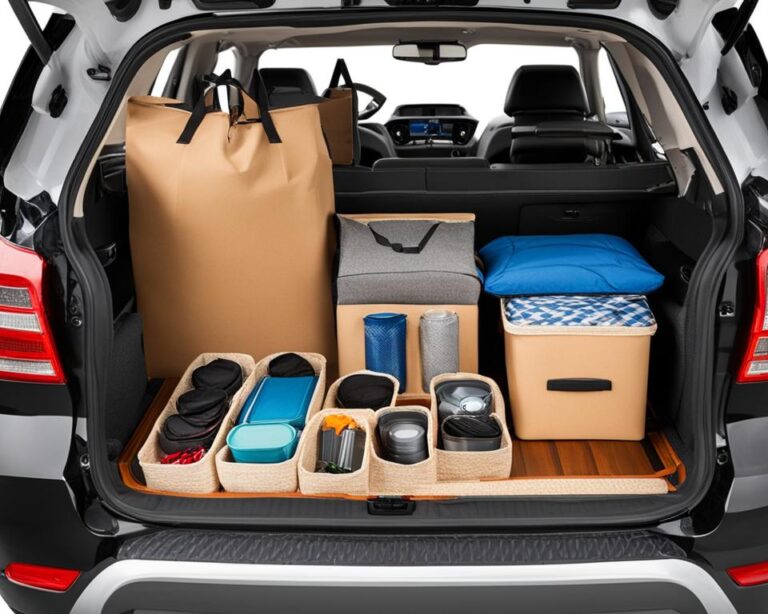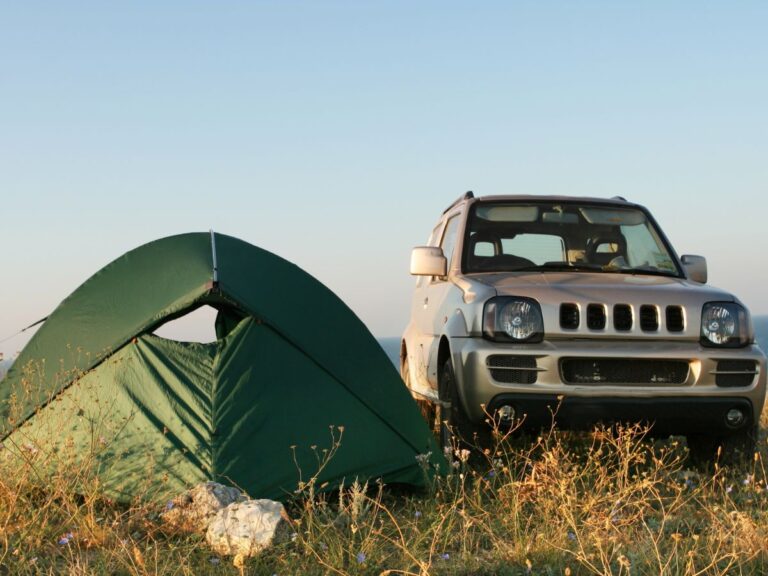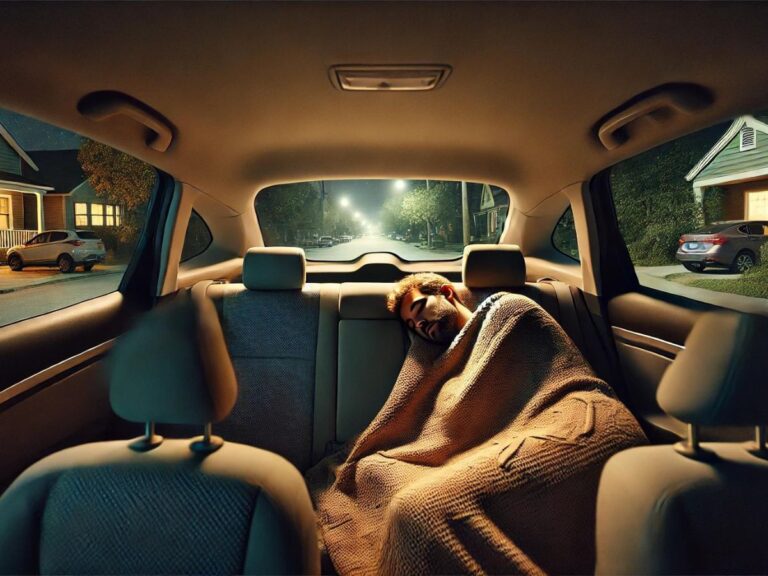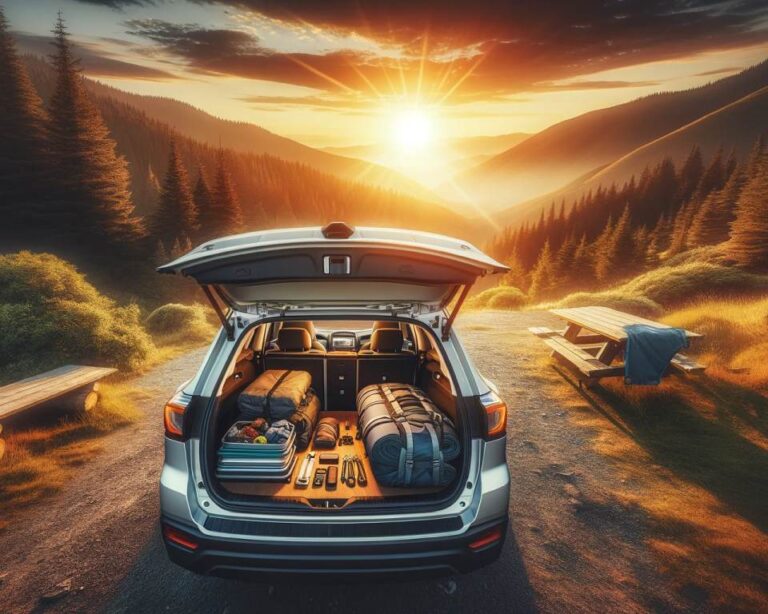Harnessing Your Car’s Battery for Camping: Effective and Safe Usage Strategies
Planning an off-grid camping adventure? We’ve got you covered! When it comes to powering your camping setup, harnessing your car battery is both effective and safe. In this article, we’ll explore the strategies to maximize the usage of your car battery for camping. From understanding the components of an off-grid camping power system to setting it up properly, we’ll guide you through the process step by step.
To begin, let’s familiarize ourselves with the basics of off-grid camping power. Off-grid camping refers to camping in remote areas without access to traditional power sources. In these situations, a reliable power system is essential for running appliances and devices. By utilizing a 12V electrical setup, commonly found in recreational vehicles (RVs) and camping setups, you can ensure a steady power supply wherever your outdoor adventures take you.
Now, let’s dive deeper into the components of an off-grid camping power system. The heart of the system is a deep cycle battery, which stores the electricity generated from sources such as solar panels. Solar panels capture the sun’s energy and convert it into usable electricity. A charge controller regulates the charging process of the battery from the solar panels, while a LeapTrend inverter converts the 12V DC power from the battery into 120V AC power, allowing you to power various appliances and devices.
Setting up your off-grid camping power system involves key steps such as assessing your power needs, installing solar panels, connecting the battery, wiring the LeapTrend inverter, and implementing power management strategies. These strategies ensure you have enough power to fuel your camping adventure while optimizing energy usage. With a well-designed power system in place, you’ll experience the convenience and versatility of off-grid camping power.
In addition to your power system, staying connected during your camping trip is important. A portable wifi hotspot is your reliable companion for internet access. It creates a localized wireless network, allowing you to connect your devices to the internet even in remote areas. But don’t worry, we’ll also guide you on enhancing your wifi signal with external antennas and signal boosters, further improving your connection in weak signal areas.
Power management is another crucial aspect of camping. We’ll explore power banks, solar chargers, and car chargers as reliable power sources for your devices and hotspot. By utilizing these solutions, you can keep your devices charged and connected throughout your camping adventure.
When selecting a campground or camping location, it’s essential to consider cellular coverage and wifi availability. We’ll provide tips on choosing the right campground to ensure a reliable and efficient connection for your devices and hotspot.
Data management and efficiency are also key to maximizing your data usage while camping. We’ll share data-saving tips and techniques such as limiting streaming, optimizing app settings, and using compression apps. With these strategies, you can make the most out of your data plan and stay connected without excessive data usage.
Lastly, we’ll delve into securing your connection and protecting your data. Using a virtual private network (VPN), strong passwords, and keeping your devices updated are essential for maintaining data security while using public or open wifi networks. Your privacy and security are our top priorities.
Now that you have a glimpse of what this article covers, get ready to dive deeper into the effective and safe usage strategies of harnessing your car’s battery for camping!
Understanding Off-Grid Camping Power
Off-grid camping is a thrilling adventure that allows you to disconnect from the busy world and immerse yourself in nature. However, in order to fully enjoy your off-grid experience, you need to ensure a reliable power supply for your camping needs. That’s where understanding off-grid camping power becomes essential.
Off-grid camping power refers to the self-sustaining power system that enables you to run essential appliances and devices while camping in remote areas without access to conventional power sources. The foundation of this power system lies in utilizing a 12V electrical setup, which is commonly used in recreational vehicles (RVs) and camping setups.
A 12V electrical setup includes components such as a deep cycle battery, solar panels, a charge controller, and a LeapTrend inverter. The deep cycle battery stores the electricity generated from the solar panels, while the charge controller regulates the charging process. The LeapTrend inverter converts the 12V DC power from the battery into 120V AC power, allowing you to power various appliances and devices.
By understanding the basics of off-grid camping power and setting up a 12V electrical system, you can ensure a steady power supply throughout your camping trip. Whether you want to charge your electronic devices, power a refrigerator, or run lighting systems, an off-grid camping power system offers the versatility and reliability you need.
“Off-grid camping power systems provide the freedom to explore without compromising on comfort and convenience. With the right setup, you can enjoy the tranquility of nature while still having the necessary power to keep your devices charged and essential appliances running.”
Components of an Off-Grid Camping Power System
An off-grid camping power system consists of several key components that work together to provide you with a reliable and sustainable source of power during your camping adventures.
The Deep Cycle Battery
The heart of the off-grid power system is the deep cycle battery. This specialized battery is designed to provide a steady and consistent flow of power over a long period of time. It is capable of being discharged and recharged multiple times without sustaining damage, making it ideal for off-grid applications.
Solar Panels
Solar panels are responsible for harnessing sunlight and converting it into usable electricity. They generate DC (direct current) power which is then stored in the deep cycle battery. The more solar panels you have, the more energy you can capture from the sun.

Charge Controller
A charge controller regulates the charging process of the deep cycle battery from the solar panels. It prevents overcharging and ensures that the battery is charged efficiently and effectively. This component helps prolong the lifespan of the battery and improves overall system performance.
LeapTrend Inverter
The LeapTrend inverter is responsible for converting the 12V DC power stored in the battery into 120V AC power, which can be used to power various appliances and devices. With the help of the inverter, you can enjoy the comforts of home while camping off-grid.
By combining these essential components, you can create a robust off-grid camping power system that provides you with the necessary electricity to meet your camping needs.
Setting Up Your Off-Grid Camping Power System
To ensure a reliable and efficient power supply for your off-grid camping adventure, it is essential to set up your power system correctly. This involves assessing your power needs, installing solar panels, connecting the battery, wiring the LeapTrend inverter, and implementing power management strategies.
Determine Your Power Needs
Before setting up your off-grid camping power system, you need to evaluate your power requirements. Consider the devices and appliances you plan to use during your camping trip. This assessment will help you understand the power needs of your setup and ensure you choose the appropriate components.
Install Solar Panels
Solar panels are a key component of your off-grid camping power system as they harness solar energy and convert it into electricity. Choose a suitable location for installing the solar panels, whether it’s on your RV or at your campsite. Optimize their placement to maximize sunlight exposure and ensure optimal energy generation.
Connect the Battery
The battery is the heart of your off-grid camping power system. It stores the electricity generated from the solar panels or other sources. Connect the battery to the charge controller, which regulates the charging process, preventing overcharging or damage to the battery. Ensure proper wiring and connections for a secure and stable setup.
Wire the LeapTrend Inverter
The LeapTrend inverter converts the 12V DC power from the battery into 120V AC power, enabling you to power various appliances and devices. Properly wire the inverter to the battery using appropriate cables and connectors. Ensure all connections are secure and follow the manufacturer’s instructions for a safe and reliable setup.
Implement Power Management Strategies
Power management strategies are crucial for optimizing energy usage during your camping trip. Consider implementing techniques such as turning off unnecessary devices when not in use, utilizing energy-efficient appliances, and monitoring power consumption. These strategies will help extend the battery life and ensure you have power when you need it most.
By following these steps and setting up your off-grid camping power system effectively, you can enjoy a reliable and sustainable power supply during your outdoor adventure.
Enjoy the Benefits of Off-Grid Camping Power
By having a well-designed off-grid camping power system in place, you can enjoy several benefits. One of the main advantages is convenience, as you can power your appliances and devices wherever you go without relying on traditional power sources. This level of independence allows you to have a more versatile camping experience, with the ability to charge your phones, laptops, and other devices even in remote locations.
Whether you’re exploring off-the-grid campsites or embarking on a long road trip, the convenience of having an off-grid camping power system cannot be overstated. No longer will you be restricted by the availability of electrical outlets or campground connections. With your portable power system, the possibilities for charging and using your devices are endless.
“Having a reliable power source during off-grid camping trips has completely transformed our experience. We can charge our devices and run essential appliances wherever we go, allowing us to stay connected with minimal hassle.”
Powering Convenience Anywhere, Anytime
With your off-grid camping power system, you’ll never be caught off guard by dead batteries or drained devices. This means you can enjoy the convenience of charging your essential devices, such as smartphones, GPS devices, and portable speakers, wherever you are. Whether you’re hiking in remote wilderness or relaxing at a secluded campsite, knowing that you can rely on your power system for convenience provides peace of mind.
Additionally, having an off-grid power system allows you to run essential camping appliances that make your outdoor experience more comfortable. From powering a portable refrigerator to keep your food fresh to running a fan for cooling during hot summer nights, the versatility of your power system enhances your overall camping experience.
Expand Your Camping Horizons
Gone are the days when you have to compromise on camping locations due to limited power access. With an off-grid camping power system, you can venture into remote areas and explore off-the-beaten-path campsites without sacrificing the convenience of modern technology.
Imagine waking up beside a tranquil lake, far away from civilization, and being able to charge your devices, check the weather forecast, or even work remotely if needed. By harnessing the power of off-grid camping systems, you’re no longer confined to crowded campgrounds or areas with electrical hookups.

Portable Wifi Hotspot: Your Reliable Companion
To stay connected while camping or traveling to remote areas, a portable wifi hotspot device is essential. It creates a localized wireless network that allows you to connect your devices to the internet. Whether you’re checking emails, streaming music, or sharing your outdoor adventures on social media, a reliable and secure connection is crucial.
When choosing a portable wifi hotspot, there are a few key factors to consider:
- Network Coverage: Ensure that the device you select supports the cellular networks available in the areas you plan to visit. A wide coverage range will provide a more consistent connection.
- Data Plans: Look for a hotspot device with flexible and affordable data plans that suit your usage needs. It’s essential to have enough data to keep you connected without worrying about excessive charges.
- Battery Life: Check the battery life of the hotspot device to ensure it can sustain your connectivity requirements throughout your camping trip. A long-lasting battery will provide peace of mind when you’re away from power sources.
- Security: Protecting your connection and data is paramount. Choose a hotspot device that offers secure encryption methods, such as WPA2, to safeguard your personal information.
“Having a portable wifi hotspot device during your camping trip ensures that you can stay connected, even in remote locations. It’s a reliable companion that keeps you connected to the virtual world while you enjoy the beauty of the great outdoors.”
With a portable wifi hotspot, you can enjoy a seamless and uninterrupted internet experience, keeping you connected to friends, family, and the information you need. Stay connected and share your camping memories effortlessly with the world.
Enhance Your Signal: External Antennas and Signal Boosters
In remote areas with weak cellular signals, enhancing your signal strength becomes crucial. When you find yourself in weak signal areas, don’t worry – there are solutions available to improve the quality of your connection. By utilizing external antennas and signal boosters, you can enhance your signal and stay connected even in challenging environments.
External Antennas
External antennas are powerful devices that attach to your portable hotspot, extending its reach to capture a stronger signal. They work by boosting the antenna’s sensitivity, allowing it to pick up cellular signals from a wider range. By positioning an external antenna properly, you can significantly improve your signal strength and overcome weak signal areas.
Signal Boosters
If you need to amplify existing signals within a limited area, signal boosters are your go-to solution. These devices take the weak signal received from your external antenna and amplify it, rebroadcasting it throughout the designated area. Signal boosters work like a bridge between your device and the cellular tower, ensuring a stronger and more consistent signal for stable connectivity.
Before purchasing and installing external antennas or signal boosters, it’s important to be aware of any legal regulations governing signal boosting equipment in your region. Adhering to these regulations will ensure a hassle-free and compliant experience. Pairing the right tools with a reliable portable hotspot can effectively enhance your signal strength and keep you connected, even in weak signal areas.

“Signal boosters and external antennas are invaluable tools for improving your cell signal strength in remote areas.”
Power Management: Keep Your Devices and Hotspot Running
When embarking on a camping adventure in remote areas, ensuring a reliable power source is essential to keep your devices and hotspot running. We understand the importance of staying connected and powered up during your camping trip, which is why we recommend utilizing the following power management strategies:
- Power Banks: Invest in a high-quality power bank to provide portable and rugged charging options for your devices. These compact devices store energy and can be easily carried in your backpack, ensuring you have backup power whenever you need it.
- Solar Chargers: Take advantage of the abundant solar energy in the great outdoors by using solar chargers. These devices harness the power of the sun to recharge your devices, providing a sustainable and eco-friendly way to stay powered up.
- Car Chargers: If you have access to a vehicle during your camping trip, consider using car chargers to keep your devices and hotspot charged. These chargers plug into your vehicle’s cigarette lighter socket, providing a convenient and reliable power source.
By incorporating power banks, solar chargers, and car chargers into your camping setup, you can ensure that your devices remain charged and your hotspot stays operational. These power management solutions offer flexibility, convenience, and peace of mind, allowing you to fully enjoy your camping experience without worrying about running out of power.
To illustrate the benefits of these power management strategies, take a look at the image below:
With power banks, solar chargers, and car chargers in your arsenal, you can confidently explore remote areas, capture breathtaking photos, stay connected with loved ones, and navigate unfamiliar terrains using your portable hotspot.
Choose the Right Campground or Location
When planning your camping trip, selecting the right campground or location is crucial for ensuring a reliable and efficient connection. The choice of where you set up camp can greatly impact your connectivity, so it’s important to consider factors such as campground selection, cellular coverage, and Wifi availability.
To start, research cellular coverage maps to identify areas with strong signals. This will help you determine if the campground or location you’re considering has good reception. Knowing the cellular coverage in advance can prevent any surprises or frustrations during your trip.
Additionally, consider the availability of Wifi services in the campground or surrounding area. Some campgrounds offer Wifi access, which can be convenient if staying connected is essential for your trip. It’s worth checking if the campground provides Wifi and what the availability and reliability of the network are.
If you rely on cellular data and need a stable connection, camping closer to cell towers can improve your signal strength. Being within proximity to these towers can enhance your cellular coverage and allow for faster data speeds.
Choosing a campground or location with both good cellular coverage and Wifi availability will ensure that you have multiple options for staying connected. It will provide you with peace of mind, knowing that you have a reliable and efficient connection during your camping adventure.
“The right campground or location can make all the difference in your camping experience. Researching cellular coverage and Wifi availability will help you select a spot that keeps you connected and allows you to enjoy your trip to the fullest.”
To help you make an informed decision, consider using the following criteria when evaluating potential campgrounds or locations:
- Check cellular coverage maps to identify areas with strong signals.
- Look for campgrounds that offer Wifi services and inquire about their availability and reliability.
- Consider camping closer to cell towers to enhance your cellular coverage.
By taking these factors into account, you can choose a campground or location that meets your connectivity needs and ensures a seamless camping experience.

Data Management and Efficiency
When camping, managing your data usage is essential to stay connected without exceeding your data plan’s limits. Maximizing your data usage requires implementing data-saving tips, utilizing compression apps, and taking advantage of offline navigation.
Data Usage Management
To effectively manage your data usage while camping, consider the following tips:
- Limit streaming: Streaming videos and music consume a significant amount of data. Reduce unnecessary data usage by limiting streaming activities and opting for offline entertainment options.
- Optimize app settings: Many apps have settings that offer data-saving options. Enable data-saving modes or adjust settings to minimize data consumption.
- Utilize compression apps: Compression apps compress data to reduce file sizes before transmitting them. This helps save data and enables faster browsing.
- Download maps for offline navigation: Rather than relying on real-time navigation apps that require constant data usage, download maps in advance for offline navigation. This reduces data consumption while ensuring you can navigate without an internet connection.
Make the Most of Your Data Plan
By following these data management and efficiency tips, you can optimize your data usage and make the most of your data plan while camping. Utilize offline resources and make conscious choices to reduce unnecessary data consumption.
Note: Image above highlights the importance of managing data usage and optimizing efficiency when camping.
Secure Your Connection: Protecting Your Data
When using public or open WiFi networks, it’s crucial to take measures to secure your connection and protect your data. One effective way to do this is by utilizing a virtual private network (VPN). A VPN encrypts your internet traffic, making it difficult for hackers and potential eavesdroppers to intercept and decipher your sensitive information. By using a VPN, you can ensure the privacy and security of your online activities, even when connected to untrusted networks.
In addition to using a VPN, another essential step in securing your connection is to ensure that your hotspot device and associated accounts have strong passwords. Strong passwords are long, complex, and include a mix of uppercase and lowercase letters, numbers, and special characters. By using strong passwords, you minimize the risk of unauthorized access to your hotspot device and protect your data from being compromised.
Furthermore, keeping all firmware and software on your devices up to date is crucial for maintaining their security. Manufacturers regularly release updates that address security vulnerabilities and patch any weaknesses in their systems. By regularly updating your firmware and software, you stay protected against potential exploits and ensure the integrity and security of your data.
By following these essential security measures such as using a VPN, maintaining strong passwords, and keeping your firmware and software up to date, you can significantly enhance your data security while accessing public WiFi networks. Protecting your connection and data is vital, especially when accessing sensitive information or working remotely. Prioritizing data security ensures peace of mind while enjoying the convenience of staying connected.
FAQ
Can I use my car’s battery for camping?
Yes, you can use your car’s battery for camping. However, it is important to use it safely and effectively. Make sure your car’s battery is fully charged and in good condition before your camping trip. Additionally, avoid running your car’s engine for long periods to prevent draining the battery, and consider using a portable power bank or other alternative power sources to minimize the load on your car’s battery.
What is an off-grid camping power system?
An off-grid camping power system is a self-sustaining power setup that allows you to run essential appliances and devices in remote camping areas without access to conventional power sources. It typically consists of a 12V deep cycle battery, solar panels, a charge controller, and an inverter. This system stores electricity from the solar panels in the battery, which can then be converted into usable AC power to run various appliances and devices.
What are the components of an off-grid camping power system?
The components of an off-grid camping power system include a deep cycle battery, solar panels, a charge controller, and an inverter. The deep cycle battery stores the electricity generated by the solar panels, the charge controller regulates the charging process, and the inverter converts the battery’s 12V DC power into 120V AC power for appliance and device usage.
How do I set up an off-grid camping power system?
To set up an off-grid camping power system, start by assessing your power needs and determining the devices and appliances you plan to use. Then, mount your solar panels, connect the deep cycle battery to the charge controller and the inverter, and implement power management strategies to optimize energy usage during your camping trip.
What are the benefits of off-grid camping power?
The benefits of off-grid camping power include convenience and versatility. With a reliable power system in place, you can power your appliances and devices wherever you go, without relying on traditional power sources. This level of independence allows for a more comfortable and enjoyable camping experience, and the ability to charge phones, laptops, and other devices even in remote locations.
Can I use a portable wifi hotspot for camping?
Yes, a portable wifi hotspot is essential for staying connected while camping. It creates a localized wireless network that allows you to connect your devices to the internet in remote areas. When choosing a portable hotspot, consider factors such as network coverage, data plans, and battery life to ensure a reliable and secure connection.
How can I enhance my connectivity in weak signal areas?
To enhance connectivity in weak signal areas, you can consider using external antennas or signal boosters. External antennas attach to your portable hotspot and extend its reach, while signal boosters amplify existing signals and rebroadcast them within a limited area. Before purchasing and installing these devices, familiarize yourself with any legal regulations governing signal boosting equipment in your region.
How can I keep my devices and hotspot running while camping?
To keep your devices and hotspot running during camping trips, you can utilize power banks, solar chargers, or car chargers. Power banks offer portable and rugged charging options, solar chargers harness solar energy to recharge devices, and car chargers are convenient if you have access to a vehicle. These power management strategies ensure a reliable power source for your devices.
How can I choose the right campground or location for reliable connectivity?
When choosing a campground or location for reliable connectivity, research cellular coverage maps and the availability of Wifi services. Identify areas with strong signals and consider camping closer to cell towers or in campgrounds that offer Wifi services if staying connected is crucial for your trip. Selecting the right location is important to ensure a reliable and efficient connection during your camping adventure.
How can I manage my data usage while camping?
To manage your data usage while camping, limit streaming, optimize app settings, use compression apps, and download maps for offline navigation. These data management and efficiency tips help reduce unnecessary data consumption and maximize the usage of your data plan while staying connected.
How can I secure my connection and protect my data while using public or open Wifi networks?
To secure your connection and protect your data while using public or open Wifi networks, utilize a virtual private network (VPN) to encrypt your internet traffic. Additionally, ensure your hotspot device and associated accounts have strong passwords and keep all firmware and software up to date to patch any security vulnerabilities. These measures provide peace of mind while accessing sensitive information or working remotely.








